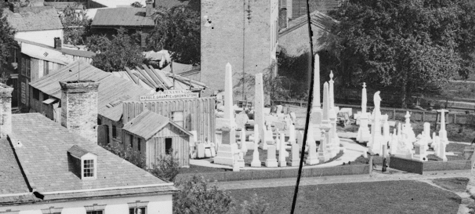![]() A long time ago, I researched the house in which then-Representative Lincoln lived on Capitol Hill. In the process, I found a great picture of the Hill, taken from the Capitol, that included Lincoln’s old lodgings. Intriguingly enough, it also showed what appeared to be a stone-mason’s shop right behind it – and only a few hundred feet from the Capitol. I decided that some day I would research whose shop this was.
A long time ago, I researched the house in which then-Representative Lincoln lived on Capitol Hill. In the process, I found a great picture of the Hill, taken from the Capitol, that included Lincoln’s old lodgings. Intriguingly enough, it also showed what appeared to be a stone-mason’s shop right behind it – and only a few hundred feet from the Capitol. I decided that some day I would research whose shop this was.
That day came today.
The first step was determining who the owner of the shop was. Although the Library of Congress has a very high resolution scan of the picture in question, it’s not good enough to actually read the sign on the front. At best, you can make out that it says “Marble, Granite & Brown Stone.”
Fortunately, the old city directories tell us that in 1887, a man named Dominic McMenamin, a marble worker, owned a shop at the corner of Pennsylvania Avenue and 1st Street SE, while living at 327 A SE. Mr McMenamin had been born in the late 1830s and had immigrated from Ireland. He had lived in DC since around the Civil War.
On 1879, the Washington Post raved about his shop, describing it as more park-like “than many that are called by that name,” going on to describe the many varied offerings to be purchased there. It concluded by saying that much of the stone was local, and was better than that which was normally used. Unsurprisingly, he was hired shortly thereafter to create a suitable memorial for one Dr. James Crowhill, who was to be interred in Congressional Cemetery.
Trouble began for McMenamin less than ten years later, when Congress decided to build a separate building for its library. The land on the other side of 1st Street SE presented itself, even though it had numerous buildings – including Mr. McMenamin’s yard – in it. After much discussion, those owning land in this area were offered compensation, though none for the damages done to his business. McMenamin and his lawyer tried every trick in order to change this, but without success.
Fortunately, McMenamin did find a place for his business close by – just a block northwest of the Capitol – and continued to operate his business there. Even the attack on his sculptures by – presumably – inebriated Naval surgeons did not dissuade him from his business.
In fact, what exactly happened is unclear, but as of 1900, no sign remains of McMenamin, his wife, or his many children. Did he take them back to Ireland? Were they involved in some calamity? No records explain any of this, and it appears that Dominic McMenamin simply disappeared in the mists of history.

